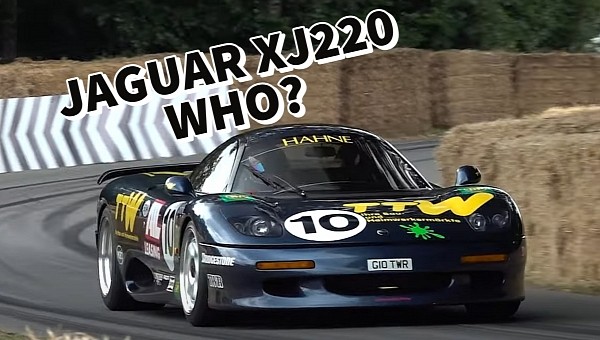When talking about iconic Jaguars, we usually think about road-going cars like the XK120 and E-Type or Le Mans-winning racers like the D-Type and XJR-9. The XJ220 supercar also gets a lot of attention, but, for some reason, the XJR-15 gets left behind. And that's a shame because it was one of the company's most daring projects.
Developed by JaguarSport, a race-oriented subsidiary of Jaguar operated by Tom Walkingshaw Racing (TWR), the XJR-15 first appeared on the drawing board in 1988. That's when Walkinshaw, having seen the XJ220 concept, began working on a road-going version of the XJR-9. Also created by Jaguar and TWR, the latter won both the 24 Hours of Daytona and 24 Hours of LeMans, as well as the World Sports Prototype Championship in 1988.
The XJR-15 project took about two years to morph into a production car. TWR's alternative to the XJ220 debuted in 1990 as the first road-going vehicle built entirely of carbon fiber and Kevlar composites. That was two full years before the McLaren F1 arrived with similar construction techniques.
While it wasn't very similar to the XJR-9 racer in terms of curb weight and overall proportions, the XJR-15 employed a long list of race-spec internals under the shell. Power came from a naturally aspirated, 6.0-liter V12 engine with an advanced "fly by wire" throttle system. Rated at 450 horsepower, it pushed the supercar from 0 to 60 mph (97 kph) in 3.9 seconds and toward a top speed of 191 mph (307 kph).
TWR built only 53 examples until 1992, including 16 race-spec cars for the 1991 Jaguar Sport Intercontinental Challenge. Essentially a customer racing program, the series included three races held throughout the year as support events for the 1991 Formula 1 championship. The race-spec XJR-15s hit the track at Monaco, Silverstone, and Spa-Francorchamps.
While short-lived, the championship gained a lot of coverage due to Jaguar's decision to award the winners a pair of Jaguar XJR-S road cars for the first two events and a whopping $ 1 million for the final race. Hoping to recover some of the cash they spent on the cars, many customers hired professional drivers for these events, which included preparation and maintenance by JaguarSport.
In addition to the 16 race cars, TWR also produced a limited-run version with a larger rear wing and altered bodywork for a Japanese customer. Called the XJR-15 LM, it received the larger 7.0-liter V12 from the XJR-9 race car, which was rated at around 700 horsepower. Only five LM-spec cars were built, while road-legal XJR-15 production came in at 27 units.
Come 2023 and the XJR-15 is a million-dollar classic with low mileage on the odometer. It's also a rare sight, with examples only showing up at events like the Goodwood Festival of Speed. If you haven't seen one in the metal yet, here's some footage from last year's edition, which saw Armin Hahne revving an XJR-15's big-displacement V12 up the iconic hill.
The XJR-15 project took about two years to morph into a production car. TWR's alternative to the XJ220 debuted in 1990 as the first road-going vehicle built entirely of carbon fiber and Kevlar composites. That was two full years before the McLaren F1 arrived with similar construction techniques.
While it wasn't very similar to the XJR-9 racer in terms of curb weight and overall proportions, the XJR-15 employed a long list of race-spec internals under the shell. Power came from a naturally aspirated, 6.0-liter V12 engine with an advanced "fly by wire" throttle system. Rated at 450 horsepower, it pushed the supercar from 0 to 60 mph (97 kph) in 3.9 seconds and toward a top speed of 191 mph (307 kph).
TWR built only 53 examples until 1992, including 16 race-spec cars for the 1991 Jaguar Sport Intercontinental Challenge. Essentially a customer racing program, the series included three races held throughout the year as support events for the 1991 Formula 1 championship. The race-spec XJR-15s hit the track at Monaco, Silverstone, and Spa-Francorchamps.
While short-lived, the championship gained a lot of coverage due to Jaguar's decision to award the winners a pair of Jaguar XJR-S road cars for the first two events and a whopping $ 1 million for the final race. Hoping to recover some of the cash they spent on the cars, many customers hired professional drivers for these events, which included preparation and maintenance by JaguarSport.
In addition to the 16 race cars, TWR also produced a limited-run version with a larger rear wing and altered bodywork for a Japanese customer. Called the XJR-15 LM, it received the larger 7.0-liter V12 from the XJR-9 race car, which was rated at around 700 horsepower. Only five LM-spec cars were built, while road-legal XJR-15 production came in at 27 units.
Come 2023 and the XJR-15 is a million-dollar classic with low mileage on the odometer. It's also a rare sight, with examples only showing up at events like the Goodwood Festival of Speed. If you haven't seen one in the metal yet, here's some footage from last year's edition, which saw Armin Hahne revving an XJR-15's big-displacement V12 up the iconic hill.












